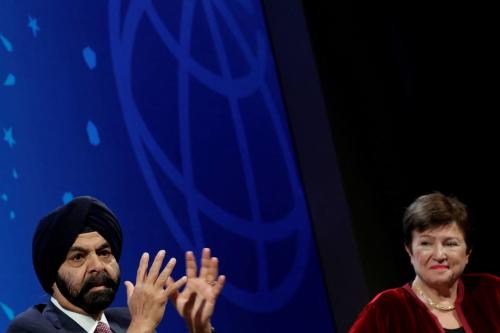Earlier this week, the World Bank published its latest estimate of global poverty, reporting that 1.01 billion people lived under $1.25 a day in 2011. Such estimates typically receive a good deal of attention and this time is likely to be no different. A goal to end extreme poverty is expected to feature as the cornerstone of a successor agenda to the Millennium Development Goals. In theory, the new poverty numbers should give a clear indication of how far we stand away from that mark, which is crucial to assessing the goal’s feasibility. Yet, in our view, the new poverty estimate fails to do this.
We are pleased to see global poverty numbers receiving greater attention. Ending extreme poverty is not the endgame of development, nor does the simple indicator of income poverty capture all aspects of well-being, but it remains a communicable and critical measure of human progress.
We also commend the World Bank for adopting its own institutional target to reduce the global poverty rate to 3 percent by 2030, and for thinking seriously about how poverty data can be improved. The World Bank, more than any other institution, understands the conceptual and empirical issues involved in monitoring poverty, as demonstrated in yesterday’s release of an impressive policy research report.
One change already in place is the bank’s commitment to report on progress against global poverty on an annual basis, where previously such updates only occurred around every 3 years. This commitment was made by President Jim Kim at his Georgetown speech in April 2013 when the bank’s “twin goals” were first unveiled. Updating global estimates every year means that new information can more rapidly inform and improve our understanding.
A good example of this is provided by India. Until Wednesday, the most recent global poverty estimates drew from India’s 2009-10 National Sample Survey, which was conducted at the height of a drought. That survey gave the impression that poverty reduction had been sluggish over the preceding 5 years, despite this being a period of record economic growth in the country. This week’s new estimates use data from India’s 2011-12 National Sample Survey, conducted when conditions were more representative. It reports about 100 million less people living under $1.25. One result is that the oft-repeated claim that the number of extreme poor living in India exceeds that in Africa can finally be put to rest. (As a counterexample, we are baffled by the bank’s decision to continue to use Nigeria’s 2010 Harmonized Living Standards Survey whose data are riddled with inconsistencies, when more recent estimates from the 2011 and 2013 General Household Survey Panel are available. Whereas the 2010 survey reports a poverty rate of over 60 percent, the more recent surveys suggest the rate is closer to 30 percent.)
At the same time, it is hard to come away from the new global estimates without feeling underwhelmed and frustrated by their limitations.
First, it is disappointing to see that the World Bank continues to generate poverty estimates based on 2005 Purchasing Power Parity (PPP) data rather than the new 2011 PPP data published earlier this year. As we pointed out in May, the new PPPs suggest that prices in developing countries are far lower than previously thought, which has a dramatic bearing on poverty numbers.
The bank has put off incorporating the new price data into its poverty calculations until it has had time to explore the changes and their causes more carefully. Such research is undoubtedly of value. Yet everything we know about the design and implementation of the 2011 International Comparison Program (the source of the new PPP data) suggests it is superior to the previous round. Choosing to delay the adoption of the new PPPs means consciously opting to employ inferior data. It also effectively puts in limbo the bank’s institutional poverty goal (including its interim 2020 target to reduce the global poverty rate to 9 percent) and more importantly, the forging of the post-2015 development agenda, which is actively being negotiated.
There is a second respect in which the World Bank’s new estimates have the feeling of immediately being old: we are furnished with global poverty estimates for 2011 as we near the end of 2014.
There is no reason why the bank could not generate provisional poverty estimates for the current year that can later be revised as and when additional data comes in. This is the approach taken with almost every other time-series of important economic data. World Bank country economists are well positioned to generate such estimates and in fact have done so in some bank regions for some time. Alongside its release of 2011 global poverty estimates, the bank has published projections of poverty for 2015 and other outer years. It is absurd that the bank is willing to provide estimates of poverty in the past and poverty in the future, while refusing to estimate poverty today.
One of the innovations introduced by President Kim is the creation of a “Delivery Unit” specifically charged with generating real-time data on key performance indicators. Shouldn’t poverty data be held to the same standard?
Finally, it is disappointing that the World Bank chose to wait so long before updating PovcalNet: the online repository of survey data which serves as the source of global poverty estimates. This update includes the addition of data from several dozen national household surveys that the bank has obtained since the last revision 18 months ago.
In recent years, PovcalNet has become an indispensable resource for poverty researchers around the world; indeed it has played its part in a mini-revolution within development research, in which more open data and social media have reduced barriers and increased accountability. The delay in updating the public version of PovcalNet, while bank staff had access to an updated internal version, certainly goes against the bank’s claim to be a leader in the open data movement.
The World Bank is charged with promoting evidence for policymaking, not data for economic historians. Yet its institutional culture seems to steer it more towards the latter than the former. As the steward of global poverty data, this has to change.



Commentary
The Poverty of Poverty Data
October 10, 2014